#pagan books
Text
Are you tired of anti-choice people telling you that your views on abortion have no historical/religious support?
Me too.
So I wrote a book proving them wrong.
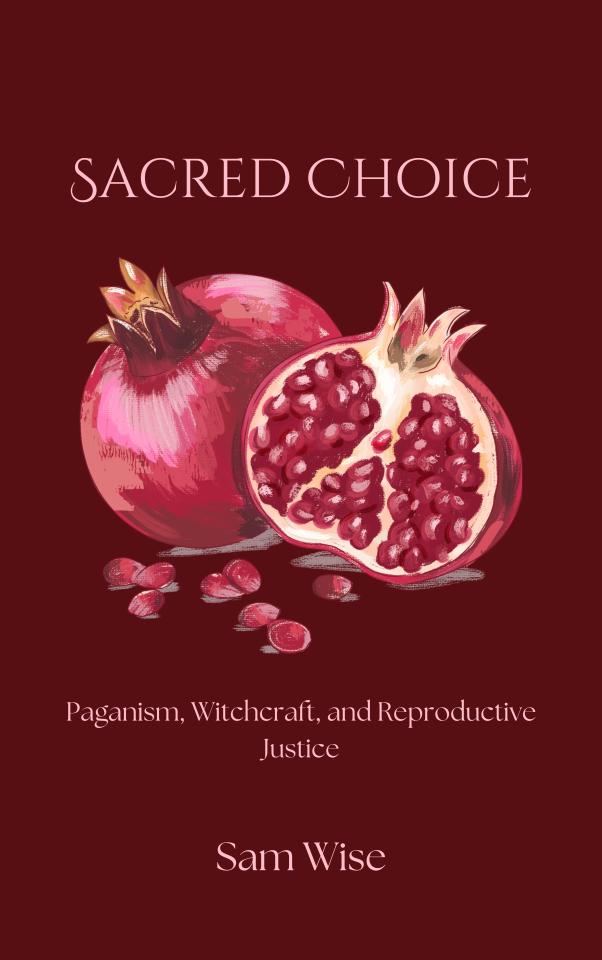
"An exploration of the history of contraception and abortion in witchcraft and paganism.
This celebration of the history and spirituality of reproductive freedom combines thorough research, reflection, and magical practice with an easy-to-understand writing style. Learn about birth control in the ancient world, which gods and goddesses were historically called on to prevent pregnancy, how to cast a spell to find an abortion provider, and more!
Written with an intersectional, trans-inclusive approach, Sacred Choice acknowledges the nuance of reproductive justice and the ways abortion and contraception access is affected by race, gender, ability, and social class."
Release Date: September 22nd, 2022 (Fall Equinox!)
Available for preorder now!
You can preorder the ePUB for $1 USD on Etsy. You will receive a bonus PDF to ensure file compatibility on all devices. Your digital files will be sent to you on the release date.
If Kindle is more your speed, you can preorder the Kindle ebook for $2.99 on Amazon. The ebook will be auto-delivered to your Kindle library on the release date.
You can also preorder the paperback for $6.99 + shipping on Etsy! Physical copies will be shipped on the book's release date, so you will receive them a few days after the 22nd.
Please note that paperback preorders are hard-capped at 100 copies. This is because I am a one-woman distribution team and want to make sure I'm able to fill orders on time. If having a physical copy is very important to you, I recommend ordering as soon as possible to make sure you get one.
I'm really excited about this project, so please do message me with any questions you have about the content, my research, or the release!
#sacred choice#sam wise author#witchcraft books#pagan books#feminist books#reproductive justice books#pro choice books#reproductive justice#reproductive rights#reproductive freedom#pro choice#abortion#birth control#dobbs vs. jackson#dobbs decision#roe v. wave#witch#witchcraft#witchblr#pagan witch#witchyvibes#paganism#paganblr#reclaiming#reclaiming witch#norse pagan#heathenry#inclusive heathenry#queer witch#queer witchcraft
670 notes
·
View notes
Text




New in the Spiral House Shop Catalog!
Art Magick: How to Become an Art Witch and Unlock Your Creative Power by Molly Roberts
Do you want to unlock your creative power and create beautiful art that is also infused with magic? If so, then Art Magick is the book for you!
This grimoire is a comprehensive guide to art magick, teaching you everything you need to know to create enchanted art objects, cast spells, and connect with the spirit world. With step-by-step instructions and illustrations, Art Magick makes it easy to get started on your journey to becoming an art witch.
Whether you're a beginner or an experienced artist, Art Magick has something to offer. You'll learn how to:
Enchant art tools and materials to produce soulful creations.
Create sacred spaces, altars and magickal allies for healing, fun and growth.
Harness color, celestial aid, poetry and personal symbols to create layers of meaning.
Banish creative doubt and strengthen your intuitive instincts.
Choose art forms and context for robust spell craft.
Uncover your gifts and enchant your world with a wide variety of media.
If you're ready to awaken the Art Witch within, then Art Magick is the book for you!
0.4" H x 10.7" L x 8.2" W (1.15 lbs) 128 pages
#art witch#art magic#art magick#magic books#pagan books#witchblr#magical books#grimoire#witch shop#witchcraft books for sale#book shop#pagan book shelf#witchy reads
150 notes
·
View notes
Text
“Freya” by Morgan Daimler (A Full Review) ✨✨✨

Rating: 5/5 stars.
-I like how Morgan Daimler separates her own experiences into their own paragraphs after stating the general unbiased and scholarly information.
-She does reference lots of sources, mostly scholars, but also the Eddas, Sagas, and physical historic evidence.
-Man does she love including Rudolf Simek’s hot takes on things. I had to look him up. But yeah. Keep that in mind. If you hate Simek you’ll probably get annoyed by all the siting of his works. I’m neutral cause I haven’t found problems so far with his opinions so it didn’t bother me.
-Love how Morgan Daimler gets into the details of theories like the Frigg = Freya theory (which I personally don’t subscribe to) and the Gullveig = Freya theory (which I actually do believe).
-You can tell Daimler put a ton of time making sure to carefully research, and also was in tune with the opinions of modern heathenry circles.
-It’s a short read, so great for my ADHD. And also it makes sense it’s short because the information that’s credible on Freya isn’t very much. So she didn’t waste pages trying to reach a word count. Concise! Very well written. Only one typo, and it’s easy to understand what Daimler meant by the context of the rest of the sentence!
-I give it 5/5 for all these reasons, but also as a devotee of Freya, it made me happy to see someone not portraying her through Wiccan tinted lenses.
#books#booklr#bookblr#witchcraft book reviews#pagan books#freya goddess#heathenry#heathen books#heathenry books#book reviews#Freya by Morgan Daimler#Morgan Daimler#pagan witch#norse mythology#norse gods#norse heathen
26 notes
·
View notes
Text
🥀Book Review: Persephone's Pathway: Wisdom, Magick & Growth by Jennifer Heather
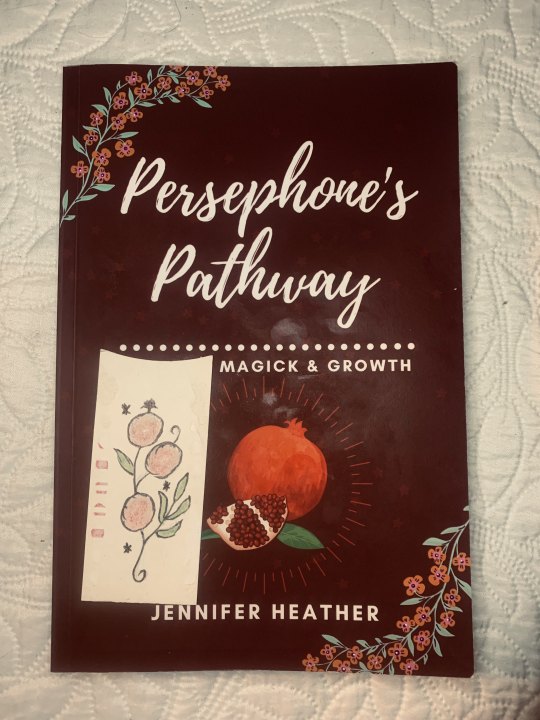
Full Title: Persephone's Pathway: Wisdom, Magick, Growth
Author: Jennifer Heather
Published by: Heather Publishing (seemingly self published) 2020
Good Reads: Link
My Quick Review: ⭐⭐⭐⭐ (4/5) stars.
Persephone’s Pathway which while flawed and at times meandering is perhaps the best resource available for the modern pagan worshipping or working with Persephone and I wholly recommend it.
Official Blurb: Persephone's Pathway is one of balance and duality; embrace the dual goddess archetype of Underworld Queen and Spring Maiden in order to achieve harmony. This book shares the wisdom of Persephone, along with spells and rituals to help you in your daily life. Shadow work exercises encourage you to work with the Underworld aspect of the Dark Goddess, whilst flower magick celebrates the joy and gentleness of the Spring Goddess. Blend the dark and light aspects together to experience how they shine a light on each other in this celebration of wholeness and authenticity.
Personal Reason for Purchasing: Was looking for a pagan/witchy perspective on Persephone and stubbled across this one. (Bought from Amazon UK)

Overview of the book's contents.
Introduction: A solid introduction, focusing on what the purpose of this book will be, and the author’s goals in writing it, namely ‘an exploration of the mythology and Symbolism surrounding Persephone, along with chapters dedicated to a facet of what she can teach us’, ‘both a collection of information and tribute to her’.
Chapter 1: 'Who is Persephone': Introduction to Persephone, her role, dual nature, The Eleusinian mysteries, possible connections to Erishkegal (a mesopotamia goddess originating 4000 BC), and of course the Homeric Hymn to Demeter.
Chapter 2: 'Historic Origins': An exploration of the genesis of Persephone in Mythology, through to the Evolution of her story in present day literature. (A personal highlight).
Chapter 3: 'A Myth Retold': A modern retelling of the hymn to Demeter by the author.
Chapter 4: 'Symbolism': An exploration of the artefacts associated with Persephone, both modern and ancient, the creation of a unique glyph/sigil for Persephone and an extensive and detailed discussion of association/correspondences, some ancient, some contemporary and lastly her common epithets.
Chapter 5: 'Creating an Altar': A collection of suggestions and guidelines on creating your own altar for Persephone and common offerings to gift the Goddess.
Chapter 6: 'Persephone Magick: Begins with a basic beginners to magickal practice, followed by a recipe for a Persephone Anointing oils, a guide to connecting to Persephone, an innovation and an adaption of the Orphic Hymn to Proserpina.

The Seeds of Persephone
A collection of chapters surrounding what the Author considers to be the six core aspects/values which Persephone embodies.
Seed 1: 'Union': Focuses on Shadow-work, divine alignment for body and Spirit union, and includes a spell for Spiritual union of lovers, guidance surrounding meditation, shadow-work rituals, and a recipe for a love attraction oil.
Seed 2: 'Balance': Begins with a discussion of how to, and the importance of maintaining balance in one’s life, including a meandering discussion of grounding, living with the seasons, incorporating nature into your life, meditation, seasonal altars, self-care, massage, and yoga. Lastly it includes recipes for a Persephone Beauty Elixer’ cream/lotion, a medicinal tonic, a spell for resolution, and a spell for making a decision.
Seed 3: 'Intuition': Looks at ways to develop one’s intuition, including an outline for a Persephone focused Lithomancy technique (10 planetary stones, 6 Persephone stones (named for each of the author’s ‘Seeds’: Fertility, Justice, Balance, Union, Sovereignty and Intuition), three tarot spreads and the script for a guided meditation.
Seed 4: 'Sovereignty': Is a discussion of [personal Sovereignty, and self-esteem, with journal prompts. Guidance on enchanting a power talisman, and a spell for protecting personal boundaries.
Seed 5: 'Justice': Focuses heavily on Persephone in her Queen of the Underworld Aspect, touching on several myths in which she acted as a Purveyor of justice, (Orpheus and Psyche, and a discussion on Trust in regards to the Goddess. Followed by Several spells for truth telling, reflection on behaviour and fair resolutions.
Seed 6: 'Fertility': Focuses on Persephone's Spring/Maiden Aspect. Followed by a discussion of Maiden goddesses, Flower Magick, creating Floral elixirs, cleansing sprays, a flower bathing ritual, and spell jars/Witch’s bottles. Followed by the Associations/correspondences and finally a script of a guided meditation, to meet Persephone in her Spring Aspect.
Appendix: The Orphic hymn to Proserpina, translated by Taylor Thomas 1792.

Personal Thoughts and Review.
I’m conflicted about this book. The first half is an excellent primer on Persephone and including her into one’s personal practice however, the second half the ‘Seeds of Persephone’ are at times Meandering, unfocused and clumsy, but there are jewels among the ramblings.
The book appears to be self published, so I’m inclined to be kinder to the Author than I would otherwise be; however, Persephone’s Pathway could really use reformatting (text justified etc), and would benefit immensely from an informed and passionate editor. Nevertheless this book is an excellent edition to the libraries of those of us who work with Persephone.
Aspects in detail.
General content: The first half goes over a lot of content around Persephone, in some detail and is appropriately referenced through allowing the reader to research further. The Second half (the Seeds) is a mixed bag and approaches certain subjects extremely casually, namely Shadow-work and herbal medicine.
Persephone’s correspondences: Primarily contained to Chapter 4, the Correspondences are in depth, reference and diverse. However, there are inaccuracies, the most obvious is a mention of Corn/Maize being cut as a part of the Eleusinian Mysteries. As a New World crop Corn was not in ancient Greece at the time and as such has no historical connection to the Mysteries. From my own understanding the crop cut during the Mysteries was likely Barley, a grain though to have great significance to the Eleusinian Mysteries as a part of the hallucinogenic cocktail thought to be drunk by initiates, barley is also part of the offering given by Oddyseus to summon Persephone (“first with milk and honey, then with sweet wine, then with water; and sprinkle white barley-meal above”).
Rituals and Spells: It’s Always interesting to see another practitioner's approach, and covering a very broad scope although, I wish they were indexed since they appear throughout the book.
Origin Myth retelling: An interesting retelling, possibly my favourite version, however it is not without flaws.
Guided Meditations: Enjoyable and Interesting, these scripts approach many aspects of Persephone’s Mythos.
Journaling Prompts: These appear seemingly at random in the latter half of the book, but are nevertheless thought provoking.
Recommended Reading: While good to see, it is worthy of note that none of these books reference Persephone, Hellenic Polytheism, or Shadow-work. Which are the topics I would like to see additional material given some of my concerns with the book itself.
Bibliography: Extensive and good practice.
The Seeds in Detail.
Given their significance to the book I’ll review these chapters separately:
Union: a clumsy chapter whose advice on Shadow-work is surface level and possibly dangerous for a beginner or someone who is mentally vulnerable. But this chapter does handle the topic of Love workings with the required levity.
Balance: Waffling and honestly feels like filler, of the seeds this one is disappointing and feels like lost potential.
Intuition: a major highlight of the book, a detailed exploration of Lithomancy, well written and thought provoking.
Sovereignty: A good chapter, if a little long winded.
Justice: Spectacular, discussion of Queen Persephone and of how to connect to the Underworld Aspect. A personal highlight.
Fertility: An excellent close to the book but desperately needs reformatting.
Final Thoughts.
I wholly recommend this book especially as a gateway into working with or worshipping Persephone. Despite its flaws, it is the best resource I’ve found on Persephone from a pagan/witch perspective, and my practice is better for reading it.

#🥀Book Review#book review#persephone#persephone worship#persephone deity#persephone goddess#persephone devotee#persephone devotion#paganblr#paganism#pagan witch#hellenic pagan#hellenic books#hellenic gods#pagan books#witchblr#witchcraft#witch book#spirituality#shadow work#greek mythology#mythology#gay witch#gay pagan
33 notes
·
View notes
Text
Pagan book lists
I like creating book lists. EDIT: There are two files available, one on Google doc, one on Cryptpad. Maybe you already know this one, about pagan deities from A - Z:
Recently, I made another one, with books focussing on the Norse deity Loki and about Inclusive Norse Paganism/Heathenry.
#Loki Norse deity#Lokean#Loki#Norse Paganism#inclusive heathenry#heathenry#pagan deities#pagans of tumblr#paganism#pagan books
80 notes
·
View notes
Text
Poison's Guide to Hekate: Deipnon, Noumenia & Other Celebrations🦋

"Black" by Aykut Aydogdu
🖤Disclaimer: A great deal of this info comes from "Keeping Her Keys" by Cyndi Brannen because I really enjoy her exercises/rituals on the subject
What are Deipnon & Noumenia?
Deipnon (Deipna) is a celebration (or more accurately a ritual) dedicated to Hekate which occurs during the new moon. Also called "Hekate's Supper", ancient worshippers would leave a meal out at the crossroads in honour of Hekate. According to Sorita d'Este, in her book "Circle for Hekate", these suppers may have been an act of charity as well as an offering. The rich would leave out food in the name of Hekate which would then be taken by the poor. The modern variation of this practice is quite similar, offerings for Hekate (food, herbs, etc.) are left out at a crossroad, after sunset, on the night of the new moon. Anything can be used as an offering but bread was most commonly used.
Although they may not be called "Noumenia", there are many ancient resources which discuss rituals performed on the first and last day of a lunar cycle. The modern interpretation of Noumenia, the day after Deipnon, is used to set intentions for the new lunar cycle.
Ancient Celebrations:
In her epithet as Hekate Kourotrophos, or Guardian of Children, Hekate was honoured 3 days a year. According to "Keeping Her Keys" those days were the 27th day of the January-February moon cycle (for 2023, that will be February 16-17), the 3rd day of the June-July moon cycle (June 21-22, 2023) and the 16th day of the August-September moon cycle (September 1-2, 2023). During those days people sought Hekate's blessing and protection over their children.
Modern Celebrations:
Hekate's Night (August 13th)
Hekate's Month (November)
The Day of Hekate of the Crossroads (November 30th)
Note: These celebrations are modern and therefore may not align with your personal practice, please do your research and read "Keeping Her Keys" Chapter 7 for more information.
"Ask Hekate whether it is better to be rich or starving; she will tell you that the rich send her a meal every month and that the poor make it disappear before it is even served." -Aristophanes, 380 BCE
My Reading List🖤
🖤Check out this source for some more information:
#witchery#witches#witch#witchcraft#witchcore#witchy aesthetic#witch aesthetic#witch asks#witchcraft 101#witches of tumblr#witchblr#witch tips#witch tools#witch talk#witchy things#beginner witch#witch blog#baby witch#pagan books#book of shadows#hellenic paganism#hellenism#hellenic#hellenic polytheism#helpol#hekate#paganism#pagan#magick#moon phases
154 notes
·
View notes
Text


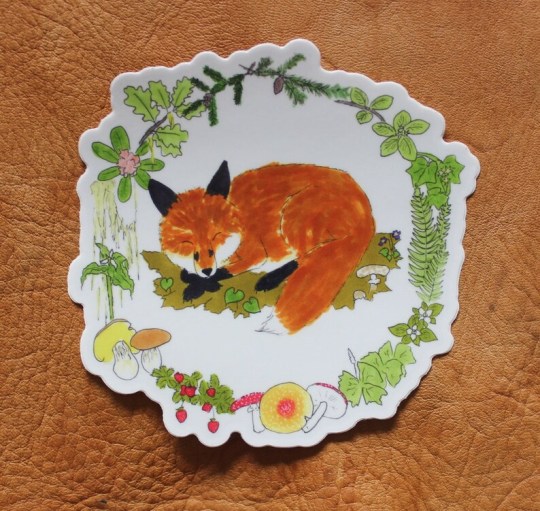

Hi, all! It's coming up on my fall sabbatical, and I'll be closing down my shops for a few weeks next week, including my Etsy, eBay, and Storenvy shops. So if you want to order any of my Pagan/Vulture Culture books, hide and bone art, stickers, customized and original finish models, and other offerings, get your orders in now or you'll have to wait til mid-November! My various shop links can be found at https://thegreenwolf.com/links/
#Vulture Culture#taxidermy#Pagan#Breyer horse#Breyer horses#model horses#stickers#nature#traditional art#books#nonfiction#oddity#oddities#curiosity#curiosities#pagan books
21 notes
·
View notes
Text
I do think magik should always be evolving with us. Which is why I was excited to learn about using coffee in magik. I have actually pre-ordered an entire book on coffee magik, "Coffee Magic for the Modern Witch", by Elsie Wild.
Coffee represents, energy, cleansing, grounding, & healing.
Element: fire
Use coffee in spells or rituals to clear/cleanse mental & spiritual blockages. Include coffee in your rituals to liberate your personal energy & increase “flow” in your life. Also good for meditating for similar reasons. Making sure you can smell fresh coffee grounds.
Placing coffee beans inside the box or bag where you keep your tarot cards, runes or other tools as an alternative to sage for keeping them clear of negative energy.
It is considered excellent to break curses, & clear blockages. As well as dispelling nightmares.
Can be used as an offering to deities, spirits and ancestors.
Adding energy or speed to your ritual.
#witchblr#pagan#paganism#norse paganism#witchy#green witch#Coffee#Coffee magik#Magic#Magick#Rituals#Cleansing#pagan books
31 notes
·
View notes
Text
Reading Lisa Lister's The Witch ( and actually planning on finishing it) and I feel it's just what I needed after feeling really down on myself lately
14 notes
·
View notes
Text
Just Magick - A Witchy Bookclub!
September 2023 - Psychic Witch by March Auryn
Hi all! After a long hiatus, I’m starting up the witchy book club again. It’s perfect timing to get us back into the swing if things right before Samhain if you have fallen off the broomstick, such as myself.
I’d you’d like to join the book club and learn with us, click the link below!
#witchblr#witchcraft#tarot#witches of tumblr#tarot community#spellwork#baby witch#witchy books#books on witchcraft#witchcraft books#witchcraft bookclub#pagan books
11 notes
·
View notes
Text
The Great Handfasting Project: Pagan Wedding Planning Books

In February, my partner and I will be celebrating our third anniversary. Like many people who have been dating for a while, we've decided to get married. Because we're both pagan, we've always known that we wanted a pagan wedding. But because neither of us is Wiccan (I'm a Heathen and he's a Roman pagan), we knew that our pagan ceremony probably wasn't going to look like a typical neopagan wedding. And, since we live in an area that doesn't have a lot of pagan resources, we knew we would be planning the ceremony and writing the ritual ourselves.
We are going to be having a true handfasting -- a Celtic-style marriage ritual that includes actually binding the couple's hands together with cord or ribbon. We're both Irish American, and we both incorporate Irish elements into our spiritual practices, even though we both have other stuff going on. We chose Lughnasadh (August 1st) as our wedding date because it's a traditional time for handfastings in Ireland, and we will be incorporating the binding of the hands. However, we're also planning for the ceremony to include lots of Norse and Roman elements. The cool thing about writing your own wedding ritual is you can include whatever religious or cultural elements are meaningful to you. (Provided you're not stealing from closed traditions you aren't a part of.)
Because I feel like struggling to plan a modern pagan wedding ceremony is a pretty common experience, I'm going to be sharing a lot of our research and planning process on this blog so you can learn from our experiences and (I'm sure) our mistakes. I'm calling this "The Great Handfasting Project."
Step one of wedding planning, as with so many things in revivalist spirituality, is research.
(I am aware that Raven Kaldera and Tannin Schwartzstein have a book on handfasting. However, I personally do not feel comfortable reading or reviewing anything with Kaldera's name on it because he has been accused by multiple former followers of some truly horrific abuse and exploitation. Aside from any ideological issues (and I do have several), I don't think someone who openly uses religious rituals to act out rape and torture fantasies is the type of person I want to take wedding planning advice from.)

Modern Handfasting: A Complete Guide to the Magic of Pagan Weddings by Liz Williams
(2021, Llewellyn Publications)
This was the first book I read after my partner and I decided we wanted a handfasting. Overall I felt like it was a great guide to modern handfasting ceremonies, especially the logistical side of planning one. (Can a handfasting be legally binding in my country? How do I handle family members who aren't pagan? What kind of venue should I book for my handfasting? Etc., etc., etc...) At the same time, this book is definitely focused on handfastings and doesn't really talk about other types of pagan wedding ceremonies. The wedding planning advice is still good, but if you're not planning a handfasting for your ceremony, the sample rituals won't be as helpful.
Pros:
Very thorough advice on how to plan a non-traditional wedding. After reading this book, I had a good idea of all the logistical stuff I’d need to do for my own wedding.
Queer and trans inclusive! The author includes extra advice and information specifically for queer couples and couples in which one or more partner(s) is trans.
Polyamory affirming! While this book mainly focuses on ceremonies with two partners, the author does talk a little bit about poly handfastings and about historic precedents for polyamory in paganism.
I liked how the author included mentions of love and marriage deities from other religions, like Hinduism and Vodou, while also talking about the dangers of cultural appropriation and making it clear that readers should seek out a clergy in those religions if they want to form a relationship with those deities.
The book is mostly very well-researched and transparent about sources.
Includes anecdotes from people who have been handfasted and from celebrants who have performed handfastings, including non-pagans.
Includes information on the legal status of pagan marriages in many different countries.
Cons:
While the author frequently mentions other traditions, most of the rituals given in this book are very much Wiccan handfastings. There’s a lot of emphasis on Wiccan ritual elements like calling the quarters and tools like athames and chalices. As someone who is not Wiccan, a lot of this just wasn’t relevant to me.
There’s not much mention of other ritual formats pagan weddings can take — which is fair, since handfasting is in the title, but this book will be less helpful to someone planning a Hellenic or Kemetic wedding, for example.
While the research is mostly pretty good, the author will occasionally come out of left field with something really “out there” and provably false, like saying that Odin’s horse Sleipnir has nine legs. (He has eight.)
The flower, herb, and tree correspondences given in this book mostly feature European species. Less helpful if you’re outside of Europe and want to use native plants in your wedding.
Overall Rating: 4/5
Do I recommend it? Yes
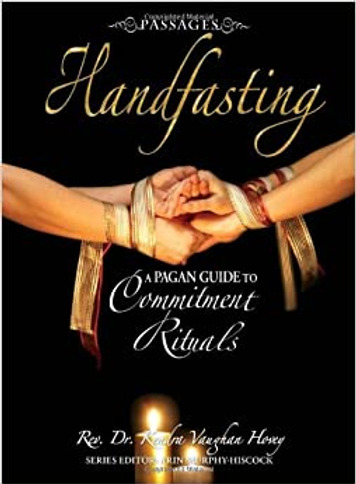
Handfasting: A Pagan Guide to Commitment Rituals by Rev. Dr. Kendra Vaughan Hovey
(2007, Provenance Press; part of the Passages series)
Although the title just says "pagan," it's made explicitly clear in the first few pages that this book is about neopagan handfasting traditions. Except not really -- the author is clearly talking about Wicca exclusively (she talks about the God and Goddess a lot and quotes from the Wiccan Rede), but she keeps insisting that these are things all neopagans believe and do. (They aren't.)
Pros:
There’s some good advice for interfaith couples, like making an effort not to prioritize one religion over the other and talking about how you’d like any kids to be raised before you get there. I especially like that the author talked about the importance of respecting your partner’s beliefs and not pressuring them to participate in your rituals.
I like that the author encourages people to incorporate family traditions, cultural traditions, or even religious traditions from their childhood if they were not raised pagan. There’s a big emphasis on personalizing your ceremony.
I enjoyed the section on themed weddings.
I appreciated that this book had information on choosing an engagement or wedding ring stone based on its magical associations.
Cons:
The author encourages couples to pick the gods they call on in their wedding ceremony based on the outcome they want that god to bring to their union. This is a big no-no because it reduces the gods to just another list of correspondences rather than autonomous beings deserving of respect.
This book contains A LOT of pretty major misinformation, like listing Pachamama as an Aztec deity (she’s worshiped by indigenous peoples in the Andes, which is fully on a different continent than the Aztec empire) and calling the Irish goddess Aine a moon goddess (she’s a solar goddess).
So much cultural appropriation. So. Much.
The author uses a lot of gendered, biological-essentialist language and insists on the importance of invoking one god and one goddess in your handfasting ceremony. There’s also a lot of penis-in-vagina sexual imagery. If you are anything but a cishet person marrying another cishet person, this is going to feel kind of icky.
The author explicitly says that pagans need to be “model citizens” (her words) and have a responsibility to make their religion look good to outsiders. That didn’t sit right with me — I don’t think anyone should live their life based on how other people might perceive them, and I definitely don’t think my wedding needs to be an advertisement for the virtues of paganism.
The author is weirdly, aggressively, anti-divorce? Even in cases of abuse or cheating? This is a direct quote from the book: “If we want our marriage to work out, it can. All we have to do is really want it.” Yikes! This kind of advice coming from a well-known reverend and high priestess is the type of thing that leads people to stay in unhealthy or abusive relationships because they feel guilty for “giving up” on their marriage.
The author is also weirdly fixated on sex and, more specifically, sexual monogamy. Normally this wouldn’t bother me, because I get that most people who want to get married are monogamous. But open marriages do exist, and can be very healthy. Not only does this book ignore that, it gets downright preachy about the importance of sexual exclusivity.
Overall Rating: 1.5/5
Do I recommend it? No. This book is 40% bad advice, 40% misinformation, and 20% information that is delivered better in the Liz Williams book.

Romantic Guide to Handfasting: Rituals, Recipes, and More by Anna Franklin
(2016, Llewellyn Publications)
Again, this book is heavy on the Wiccan influences, but it's not quite as bad as the Kendra Vaughan Hovey book -- at least t his author acknowledges that not all pagans are Wiccans.
Pros:
Gay affirming! There’s even a section specifically about gay deities to invoke in your wedding.
There’s a nice section on the history of handfasting, and on the origins of other traditions that are common in modern pagan weddings, like jumping the broom.
I liked that there was a section on wedding clothing, including tips for choosing what to wear for your ceremony.
The section on magical botanicals included detailed instructions for blending your own incenses and oils, which is helpful for readers who aren’t experienced with making their own blends.
There’s a pretty lengthy section on brewing your own wine, mead, and/or beer for the wedding feast, and it actually inspired me and my partner to do this for our handfasting feast!
I like the chapter on handparting, and I like that it includes a sample handparting ritual.
Cons:
A lot of misinformation in the deities section. For example, I don’t think most Hellenic pagans would consider Aphrodite an “Earth Mother” goddess, and as a Heathen I can definitely say that this author fully made up a new myth about Freyja, then portrayed it as an Old Norse story.
Once again, cultural appropriation rears its ugly head.
Uses the word “transsexual” interchangeably with transgender. This is an outdated term that is considered offensive by some, and by 2016 allies definitely knew not to use it.
The sections on gay weddings are much shorter and less well-researched than the sections for straight weddings. This, combined with the outdated language, makes me wonder if the author originally wasn’t going to include any info for queer couples but was pressured to add it in by her publishers. It feels insincere.
Uses the g-slur to refer to Romani people. And then suggests a [g-slur] theme as a potential wedding theme. In a book written in 2016???
Overall Rating: 2/5
Do I recommend it? No. There's some useful info, but you can definitely find that info in other books that don't contain multiple slurs (!!!) and copious misinformation.
#the great handfasting project#handfasting#wedding#pagan wedding#books#pagan books#liz williams#kendra vaughan hovey#anna franklin#llewellyn publications#inclusive heathenry#irish pagan#irish paganism#irish polytheism#heathen#heathenry#religio romana#roman paganism#roman polytheism#wedding magic#wedding witchery#witchblr#witch#wicca#long post#my writing
121 notes
·
View notes
Text
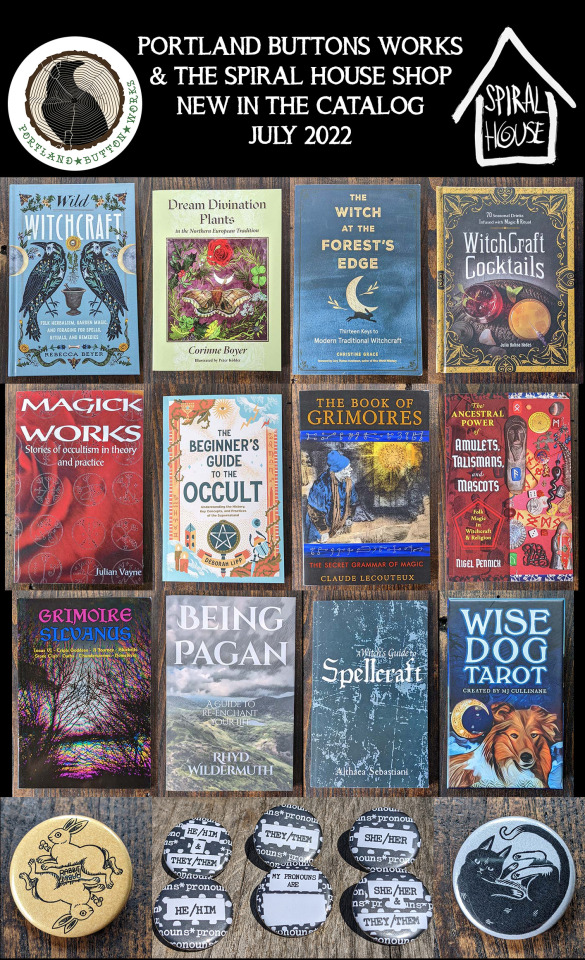
I haven't posted a shop update in awhile! Here's what's new at Portland Button Works and The Spiral House Shop for July 2022!
Wild Witchcraft: Folk Herbalism, Garden Magic, and Foraging for Spells, Rituals, and Remedies by Rebecca Beyer
Dream Divination Plants in Northern European Tradition by Corinne Boyer
The Witch At The Forest Edge: Thirteen Keys to Modern Traditional Witchcraft by Christine Grace
Witchcraft Cocktails: 70 Seasonal Drinks Infused with Magic & Ritual by Julia Halina Hadas
Magick Works: Stories of Occultism in Theory and Practice by Julian Vayne
The Beginner's Guide to the Occult: Understanding the History, Key Concepts, and Practices of the Supernatural by Deborah Lipp
The Book of Grimoires: The Secret Grammar of Magic by Claude Lecouteux
The Ancestral Power of Amulets, Talismans, and Mascots by Nigel Pennick
Grimoire Silvanus Zine Issue 6
Being Pagan: A Guide to Re-Enchant Your Life by Rhyd Wildermuth
A Witch's Guide to Spellcraft by Althea Sabastiani
Wise Dogs Tarot by MJ Cullinane
Rabbit Rabbit (on the first of the month for luck) button
Pronoun buttons (He/Him & They/Them, They/Them, She/Her, He/Him, My Pronouns are ...., She/Her & They/Them)
#CatBoss Jackie button
Orders are available for pick up in Portland, Oregon or shipped in discrete packaging across the US and around the world. Packages shipped with Priority Mail will get some extra goodies like buttons, or hand mirrors.
Upcoming 2022 Vending Events in Portland, Oregon:
August 20 - Celtic Fantasy Faire
September 18 - Columbia Willamette Pagan Pride Day
October 22 - If the Broom Fits Season of The Witch Market
#witchcraft#traditional witchcraft#witchcraft*#witchblr#witchcraft books#tarot#pagan#pagan books#green witchcraft#witches of tumblr#kitchen witch#divination#occult#grimoires#witch shop
388 notes
·
View notes
Text
Scott Cunningham, Queer Wiccan, Beloved Witchcraft writer
"Written by his younger sister, Christine, this biography of Wiccan trailblazer Scott Cunningham (1956-1993) is a fitting and loving tribute to a queer man who helped usher witchcraft into the mainstream.
His 1988 guidebook, "Wicca: A Guide for the Solitary Practitioner," is one of the most popular and bestselling books on the subject ever sold. That book joins an influential oeuvre of well-received volumes and collective series on metaphysical and organically magical art forms of witchcraft, the elements, astrology, Tarot practices, crystals, herbology, and nature, among others. His books were heralded for their smooth yet instructional prose, nonconfrontational openness, and kind approaches to often tabooed or harshly criticized practices, particularly within queer communities.
Cunningham's unparalleled knowledge of these subjects as a seasoned practitioner reflects a lifelong passion for nontraditional spirituality. As his sister notes about her beloved brother in her book, "Scott Cunningham — The Path Taken: Honoring the Life and Legacy of a Wiccan Trailblazer," he "gave not only permission, but the tools, to anyone who wished to follow a Wiccan path without having access to a coven."
Continue in the article.
#Scott Cunningham#Christine Cunningham Ashworth#Wicca#paganism#pagan books#witchcraft#nature#gemstones#rituals#witch blog#witches of tumblr#witchblr#witchy vibes#paganblr#pagans of tumblr
5 notes
·
View notes
Text
🥀Book Review: Pagan Portals: Persephone by Robin Corak
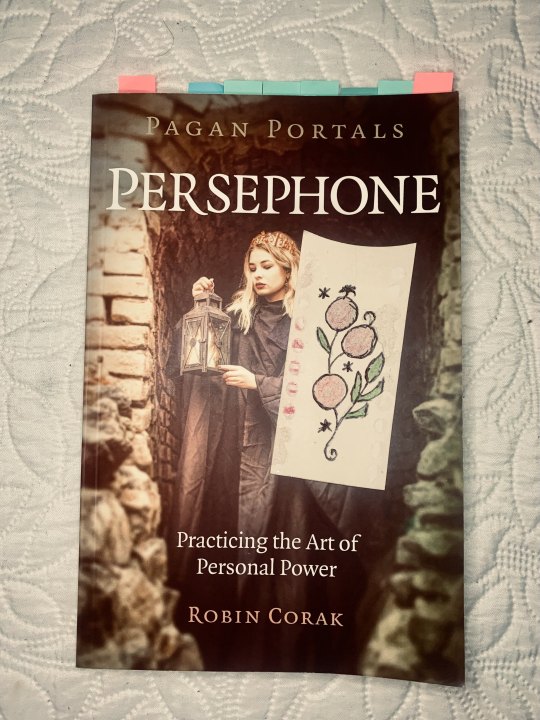
Full Title: Pagan Portals: Persephone, Practicing the Art of Personal Power.
Author: Robin Corak
Published by: Moon Books (John Hunt Publishing) 2020
Good Reads: Link
My Quick Review: ⭐⭐⭐ (3/5) stars.
A good Persephone themed self-help book, touching on shadow work, Persephone's Mythos and with some interesting resources. I recommend it but not enthusiastically.
Official Blurb: Embark upon a powerful journey with Persephone, queen of the Underworld and Goddess of Spring, as she helps you discover your personal power and take control of your life.
Personal Reason for Purchasing: I was familiar with several other Books in the Pagan Portals and bought this one hoping for a primer on Persephone's Mythology and modern pagan practice. (Bought from Amazon UK).

Overview of the book's contents.
Introduction: An Introduction to the Author, their Personal Practice and their Experience Working with/Learning from Persephone.
Chapter 1: 'From Helpless child to Powerful Woman'. A basic but welcome introduction to the core Myths of Persephone, The Homeric Hymn to Demeter, and a Personal retelling by the Author of the Abduction of Persephone by Hades, told from Persephone's Perspective and with a core theme of empowerment, self-determination/personal sovereignty. Includes journaling prompts.
Chapter 2: 'The Eleusinian Mysteries'. An Overview of the Eleusinian Mysteries with discussion surrounding what they may have entailed and the possible lessons/take-aways initiates would have received. Includes journaling prompts.
Chapter 3: 'Descent and Ascent'. Primarily a self-help section, discussing Persephone's personal ascent and descent into the Underworld and her growth from it. followed by an exploration of how such an ascent and descent into the shadow self might promote growth in the reader. Including the script for a guided meditation and journaling prompts. .
Chapter 4: 'Persephone as a Psychopomp'. An Exploration of Persephone as a Psychopomp (defined as 'a guide with the realm of souls'), touches on the idea of Persephone as a Triple Goddess, with a description of the Nekromanteion. Followed by a discussion of how to access ancestral wisdom, the wisdom of ones own subconscious. Including the script for a guided meditation and journaling prompts. .
Chapter 5: 'Persephone and the Art of Discernment'. Focusing on discernment (defined as 'acute judgement and understanding'), with suggestions on how to develop this skill. Includes several divination/discernment techniques using bay leaves. Includes journaling prompts.
Chapter 6: 'Rituals for Persephone'. Includes rituals from the dark and light half of the year (one ritual for each) and the script for a guided meditation with the aim of building personal sovereignty and highlights themes discussed in previous chapters.
Chapter 7: 'Forging the Path: Additional Methods for Connecting with Persephone'. Begins with an extensive list of correspondences, several chants/invocations, recipes for a Persephone Incense/Bath Tea and an anointing oil, with some discussion of the ingredients' significance. Followed by an explanation for a unique Divination style using Lithomancy dedicated to Persephone known as 'Persephone's Seeds of Wisdom'.
Chapter 8: 'Persephone's Feast'. Contains several culinary recipes incorporating foods sacred to Persephone or with 'Greek Flavour', contributed by Steven Corak. (Recipes are as follows: Greek summer salad : Pomegranate vinaigrette : Pomegranate chicken and kale : Pomegranate reduction : Persephone's Pastries)
Conclusion: It is a conclusion, with some final journaling prompts.

Personal Thoughts and Review.
While I was hoping for an overview of Persephone's: myths, cults, correspondences etc, what this book is at its heart (imo) is a pagan self-help (maybe shadow-work) book using Persephone as inspiration and theming.
While a generally pleasant and quick read (around 95 pages of text) there are portions where sentiment is repeated and perhaps hammered home a little to hard, however for what this book is rather than what I wished it to be, Pagan Portals Persephone is an excellent example of how to learn from myth and grow from the lessons + experiences therein, and I do recommend it to those interested in Persephone from a Pagan perspective, but it probably shouldn't be your first book on the Goddess.
Books Content in detail.
General content: Pretty surface level, but well done given the short page count.
Journaling exercise: Themed primarily around shadow work, the questions were In depth and thought provoking (however, as a Masc (he/him) individual I did notice they were written assuming for a Fem reader). I found them useful and have completed the exercise twice so far and have learned more of myself each time.
Origin Myth retelling: Interesting and inspiring but undoubtedly written with the lens of supporting the ‘self-help’ personal sovereignty narrative of the book.
Persephone’s correspondences: Broad but far from exhaustive, simply a non-referenced list.
Rituals and Meditations: Interesting as always to see another practitioner’s approach, I did notice certain Wiccan elements (casting circles, Athame/tools, ‘So mote it be’) not a complaint but worthy of note.
Recipes: I’m not qualified to answer this, and food quality is always down to personal taste anyway. However, it is an interesting concept.
Persephone’s Seeds of Wisdom: A personal highlight from the book, I use a modified version of this method in my own practice.
The most interesting hot takes from the book.
Triple Goddess Persephone: While a throw away comment in Chapter 4, the idea of Persephone embodying all Three aspects of the Triple Goddess (namely the Maiden, Mother, Crone archetypes) is interesting, and has inspired me to explore the idea further.
Personal Myth Retelling (Mythic fanfic): It is definitely decisive to rewrite myth within pagan circles, but isn’t that what Humanity have done from the Dawn of time, and perhaps by personally retelling Persephone’s transition from Kore to Queen, we might learn which aspects of the Myth, Goddess and their role in our practice are most influential to us as individuals. (Obviously attempting to masquerade one’s personal retelling (myth Fanfic essentially) as the one true version is mind numbing, but on a personal level it may be useful.)
Final Thoughts.
While not what I expected, Pagan Portals Persephone has taught me alot, and added to my personal practice, but I am glad I got the this book while equipped to recognise what the text is missing.

#🥀Book Review#book review#persephone#persephone worship#persephone deity#persephone goddess#persephone devotee#persephone devotion#paganblr#paganism#pagan witch#hellenic pagan#hellenic books#hellenic gods#pagan books#witchblr#witchcraft#witch book#spirituality#shadow work#greek mythology#mythology#gay witch#gay pagan
5 notes
·
View notes
Text
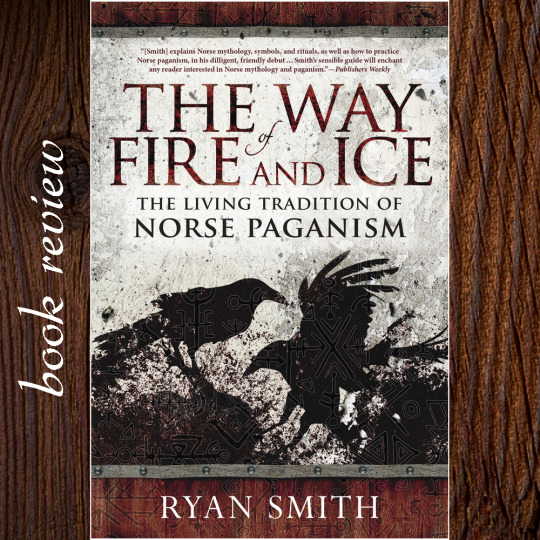
Book review
»The Way of Fire and Ice – The Living Tradition of Norse Paganism« by Ryan Smith
In this book, the author presents the modern tradition of Radical Norse Paganism, also known as »The Way of Fire and Ice«, which is very inclusive and open to everyone regardless of gender, race, mental or physical abilities, where they are from and so on.
Ryan Smith also not only distances himself from Neo Volkisch, fascist and white supremacy ideologies and groups, but also elaborates about how to fight back as a Norse pagan against people who have such destructive attitudes and beliefs.
There are chapters about the Norse Gods, Developing Spiritual Practice, Core Values of Norse Paganism and in the chapter about Runelore, the author presents the three different historic rune systems: The Elder Futhark, The Younger Futhark and the The Anglo-Saxon Futhorc, describing the meanings of each runes and explains how you can use them in divination, magic and more, for instance as bindrunes or single runes.
The author also explains the Norse concepts of Hamr (the body, the physical form), Hugr (the mind), the Fylgja (a sort of spiritual shadow which can be a spirit guide and can also take the form of an animal) and Hamingja (luck, connected to fate).
In the chapter »The Art of Seiðr«, Ryan Smith describes the main three forms of this Norse form of magic: Utiseta (which is similar to meditation, trance, and shamanic journeying or hedgeriding) direct Sorcery and Spae (which is similar to mediumship, a form of possessory trance) and points out that many Norse pagans do not do Spae. And if you feel called to this kind of work you should by all means learn it with an experienced teacher, because Spae can be dangerous if you have not been trained well.
The last two chapters focus on Finding and Building Community, with lots of good suggestions about what to do and what to avoid.
Appendix I has Further Reading suggestions and I can very much recommend to read the
Appendix II which is about The Origins of the Pagan Revival since the 19th century until the situation today. In this, the author elaborates again on the neo Volkisch movement, different groups of it and how these finally got more and more banned from Norse Pagan spaces.
At the end of the book, there is an extensive bibliography and each chapter has a list of fotenotes.
Last but not least, here is a tiny detail I liked a lot: The author mentions that the genders in this book have been set to »they/them« where possible, for instance for the description of Loki (a deity which can be seen as genderqueer or genderfluid due to some myths).
Conclusion: From all the books I read about Norse Paganism and Heathenry so far, this has been the one which elaborates the most about the dangerous Neo Volkisch movement and related fascists, its history and what inclusive Norse Pagans do to fight back against it. Thus, this book is very political and the way I see it, knowlegde about these topics is very recommendable for any Norse pagan or heathen.
Link to the book: https://llewellyn.com/product.php?ean=9780738760049
#inclusive norse paganism#norse pagan books#book review#pagan community#inclusive heathenry#the way of fire and ice#radical norse paganism#pagans of tumblr#paganism#pagan book reviews#pagan books#heathenry#anti fascist
112 notes
·
View notes
Text
Necromancy & Reanimation In Ancient Times🕯

Dead Man's Tongue by Karol Bem
🖤This post focuses on necromancy during ancient Greece/Rome, methods will differ depending on the tradition.
Ancient Classifications of the Restless Dead:
Note: In ancient times, the restless dead tended to be the ones exploited for magical endeavours.
Aôroi- those dead before their time, which is anyone who died of anything other than natural causes in old age.
Bi(ai)othanatoi- those dead by violence, includes those who died at war, executed criminals or murder victims.
Agamoi- those dead before marriage, includes both males and females.
Ataphoi- those deprived of burial, anyone who died without a proper burial were unable to rest peacefully.
Features of Ancient Necromancy:
Note: Ancient necromancy is the act of communing with the dead, this is often done with the help of oracles of the dead.
It always takes place at night
Rites require a pit and a fire
Libations of honey-milk, wine, water, olive oil (occasionally) and barley are offered to the dead
Black cattle are sacrificed for the entities of the underworld, the blood is drained into the pit and the remains are burned whole
Prayers are made to both the dead and their rulers, which secures the soul's temporary release from Hades
Features of Ancient Reanimation:
Note: Reanimation originates from Egypt and differs from necromancy in both method and appearance.
The corpse must stand before it can speak, the act of standing symbolizes its return to life
Herbs are used to reanimate the corpse
The dead being revived is always angry at their revival, unlike in necromancy which is often enjoyed by the dead
Reanimation always fails the first time, the threat of a second attempt is what makes the reanimation successful


*All images are from Pinterest*
#witches#witchblr#witch#witchcraft#magick#witch tips#witch tools#witch talk#witchy things#witchcraft 101#witchcore#baby witch#witch blog#pagan books#witch books#book of shadows#banefulmagick#baby witch tips#witch basics#witch beginner#beginner witch#witch community#deities#death witch#death work#hellenic polytheism#paganism#pagan#mediumship#hellenic pagan
104 notes
·
View notes